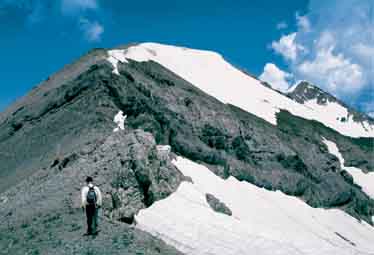|
Links to other sites:
Ordering books & Maps
Comments about this site or our book:

|
Mount Nebo, the centerpiece
of the Mount Nebo Wilderness Area, is the highest peak in the
Wasatch Mountains. As one might expect, the views from its summits
are spectacular, but it is also one of the most strenuous hikes
in this book. The trail to the southern summit climbs 5,400 feet,
over a mile of elevation gain, in only 6.6 miles of trail; and,
to make matters worse, there is no reliable source of water along
the way. Most people who climb Nebo reach only the southern peak
(11,877 ft.), where the trail stops, but the northern peak (11,928
ft.) is actually the highest point. The two lie about a mile
apart on a long knife-edge summit ridge, with a third, slightly
lower peak between them.
Many hikers climb Mount Nebo’s
southern summit as a day hike, and a few hardy souls even manage
to ascend the northern peak in one day. But it is a very strenuous
climb, and if you enjoy the mountains I suggest an overnighter
might be more appropriate. There are several good campsites along
the way, and the extra day will give you time to really appreciate
the rugged alpine wilderness.
Day 1
From the trailhead the Nebo Bench
Trail begins by ascending in a westerly direction through the
dense conifer forest. Then, after about 0.5 mile, it swings to
the north to begin the first of four wide, altitude-gaining switchbacks
up to Andrews Ridge. This section of the trail appears to have
been improved and relocated in the early 1990s, probably for
the benefit of the many pack horses that use the Nebo Bench Trail.
After 2.0 miles the trail finally breaks out of the forest into
a relatively clear area of wildflowers, sage brush, and scattered
shrub oak. This clearing represents the beginning of Andrews
Ridge, up which the Nebo Peak Trail runs for the next 1.5 miles.
The Nebo Peak Trail departs from
the Nebo Bench Trail just above the point where it first reaches
Andrews Ridge. Watch carefully as you leave the clearing, and
after about 200 yards you should see a smaller trail leaving
the main trail on the left. The Peak trail is unmarked and, worse,
it is obscured by a dense undergrowth of gamble oak, but if you
are attentive, you should be able to spot it. The main trail
continues climbing gradually in a northerly direction, while
the trail to Nebo Peak rises more steeply to the west.
Beyond the trail junction the Nebo
Peak Trail makes its way westward along Andrews Ridge for a distance
of 1.4 miles before finally dropping off the north side of the
ridge. I suggest you establish a camp here at the top of the
ridge. At this point you are 3.1 miles from the south summit
of Mount Nebo, and the elevation is 9,450 feet. There are also
some nice camp sites on the summit ridge, 1,100 feet higher,
but you will sleep much better at the lower altitude. Furthermore,
carrying a backpack above 10,000 is very tiring.
Day 2
From the top of Andrews Ridge the
trail bears north for 0.9 mile, crossing into South Nebo Basin,
and then turns west again for the climb up to the top of the
summit ridge. Don’t be confused by another less well used
trail that continues north across South Nebo Basin. This is the
old route of the Nebo Bench Trail. Finally, 1.3 miles after leaving
Andrews Ridge the trail reaches a shallow saddle in the summit
ridge. An old wooden sign indicates that this is also the point
where Willow Creek Trail reaches the ridge. The Willow Creek
Trail is another route to the top of Mount Nebo that begins east
of the town of Mona.
The next 1.3 miles along the summit
ridge, towards the base of Mount Nebo’s south peak, is probably
the most pleasant part of the hike. The views are outstanding.
On the west side of the ridge is the farming community of Mona,
surrounded by fields of grain and alfalfa, with I-15 snaking
past on its way up the Utah Valley. To the east, as far as the
eye can see, are mountains and forests-Uinta National Forest,
Manti-La Sals National Forest, and beyond that, Ashley National
Forest. But most spectacular of all is the view to the north
along the summit ridge. The three peaks of Mount Nebo, each one
more rugged than the last, cling tenuously to the knife-edge
ridge of uplifted limestone as they reach for the open sky above.
Even in July the ridge is often accented with patches of white
snow, and the prevailing west winds frequently pile the snow
into long graceful cornices along the eastern side. The trail
avoids the cornices by staying slightly below the western side
of the ridge.
Just before reaching the south
summit the trail crosses a small flat bench, then it climbs the
last 500 feet to the top. The trail ends at the south summit,
and this is as far as most people go. The north summit, 0.9 mile
further on, is 51 feet higher, but getting there and back adds
at least two more hours to the hike. The route is not technically
difficult, but some hand-over-hand scrambling is required and
there are a few places where a fall could be disastrous. The
north summit is particularly dangerous in bad weather. Do not
attempt to reach it unless you have plenty of time and the weather
is good. |
